Top News

July 14, 2014 Ryukyu Shimpo
Morinobu Tobaru has been trying to cultivate apples in the Nodake district of Ginowan City. He succeeded in cultivating shinanosuit, a type of apple.
The fruit is blue-green, not like red apples. Tobaru said, “It tastes as sweet as regular apples.” He went on to say, “I want to prove that we can cultivate apples in Okinawa.”
Tobaru has been cultivating other types of apples.
He ordered a nursery stock of shinanosuit last January and planted it at his garden. The flower bloomed at the end of last year. Before long, it produced a fruit, which grew and ripened.
To protect the fruit from natural pests such as birds, insects and bats as well as typhoons, Tobaru spread a fly screen over it. Tobaru said, “I think other types of apples planted at my garden will produce fruits.”
(English translation by T&CT)
Go to Japanese

July 10, 2014 Ryukyu Shimpo
On 6 July, a symposium to promote a future of friendly Japan-China relations through the learning of languages was held at the Okinawa City Civic Hall in Yaeshima, Okinawa City. With Professor Moritake Tomikawa of the Okinawa International University as coordinator, panelists stressed that youths from both countries should interact through language learning.
Associate Professor Hong Chenhui from China’s Fujian Normal University, who has experience teaching Mandarin in high schools in Okinawa, said, “Okinawa and Fujian have had a historically close tie. Through interacting and learning words from both languages to understand each other, I hope we can build a future where the youths are friendly to each other.”
Chairperson of the Society for Testing Chinese Proficiency, Japan, Keiji Ueno, said, “The number of students taking the Test of Chinese Proficiency is showing a declining trend in recent years, from a peak of 25,000 to about 15,000. This might be caused by issues surrounding Japan-China relations, such as the Senkaku/Diaoyu Islands dispute. However, the ability to get a deeper understanding of our neighboring countries through the study of their languages is something that will never change.”
Fujian Normal University lecturer Huang Yiyan explained that in Fujian Province alone there are 26 universities offering Japanese Language studies. He said, “The number of Japanese learners in China in general is increasing. I would like to deepen our mutual understanding by encouraging people to understand the languages of both countries.”
Akemi Sesoko of the Japan Institute of Culture and Economics (Naha) stressed the importance of learning new languages to prevent misunderstanding. She said, “Even for international relations, people should not come to a conclusion just based on bits and pieces of information. Instead, it is important that people arrive at a conclusion by learning the languages, and looking at the original source.”
Wang Dongyan, who runs the Asahi Chinese Class in Naha, said, “The current social trend where people dislike others even if they have never met is strange. I would like to develop mutual understanding with having conversations together.”
(English translation by T&CT and Lima Tokumori)
Go to Japanese
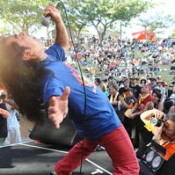
July 14. 2014 Ryukyu Shimpo
The 32nd Peaceful Love Rock Festival 2014 was held at the Okinawa City Open Air Stage on July 12 and 13. Legendary Okinawan rock musicians performed, exciting the audience with their heavy, original pieces on the night of the summer.
Ten bands, including Haebaru BeBops, which was chosen to perform in auditions for the festival, Take Out and Kachan took part. According to the organizer, 1,500 rock fans attended the festival.
Veteran rock groups, including Jet, which performs in Okinawa City, whipped the crowd into a frenzy in front of the stage. The audience enjoyed the rock festival, now a major annual summer event. Rock N’Roll Band Murasaki gave the closing performance, impressing the audience with their music skills and poise.
(English translation by T&CT)
Go to Japanese
July 12, 2014 Ryukyu shimpo
Three treaties, which were signed between the Ryukyu Kingdom and other countries about 160 years ago have provided a new perspective on the current state of Okinawa, its modern history and the hardships experienced by Okinawan people.
These treaties will serve as a great stepping-stone to the future when the Okinawan people will assert the right to self-determination.
In 1854, a Treaty of Amity between the Ryukyu Kingdom and the United States was concluded, which was followed by the conclusion of a Treaty of Amity between the Ryukyu Kingdom and France in 1855, and Holland in 1859. Some international law scholars suggest, based on these treaties, that Japan’s annexation of the Ryukyu Kingdom, which is called “Ryukyu Shobun” or disposal of the Ryukyu Kingdom, in 1879, was an unjustified act according to customary international law at the time. They allege that the Okinawan people could press the Japanese government to reconsider the unwarranted act in the context of international law of today. Article 51 of the Vienna Convention on the Law of Treaties provides that: “The expression by a State of consent to be bound by a treaty which has been procured by the coercion of the representative of that State through acts or threats directed against him shall be without any legal effect.”
Regarding the issue the scholars pointed out, an official of the Foreign Ministry avoided a direct answer to the Ryukyu Shimpo reporter, saying that it is difficult to comment definitely on it. We would like to investigate further the facts of the Japanese government’s violation of the sovereignty of Okinawa by force, in terms of the Ryukyu shobun. Okinawan public opinion on pursuing restoration of sovereignty will grow in the future.
After the Ryukyu Shobun, the government also carried out Japanization or imperialization policies in Okinawa. As a consequence of it, the tragedy of the Battle of Okinawa occurred. After the war, Okinawan people have been suffered from human rights violations and abuses under the U.S. military occupation. We have also continued to be oppressed by the heavy burden of the military bases after Okinawa’s reversion to Japanese sovereignty. When considering the status and history of Okinawa like this, we realize that all problems come from the Ryukyu Shobun. There have been many points of views on this subject among scholars and journalists through history. Fuyu Iha, the founder of modern Okinawan studies, is known for describing the Ryukyu Shobun as an emancipation of slaves. He viewed Japan’s annexation of the Ryukyu Kingdom as an evolution in Okinawa’s history.
However, the government has messed with the Okinawan people, who have lost their right to self-determination by the Ryukyu Shobun. Chofu Ota, a journalist who had preached to the people that they become Japanese nationals, lamented that Okinawa had become a“sponger” like a colonized country. We have been faced with an absurd situation that stems from the Ryukyu Shobun.
Hideaki Uemura, a professor at Keisen University, suggests the Ryukyu Shobun has no legitimacy in international law. He has pointed out that colonialism has been continuing in Okinawa, where the Japanese government has disregarded the people’s decisions on the U.S. military issue.
The Okinawa Defense Bureau has started construction of an alternative base for the U.S. Marine Air Station Futenma despite objections from the local people. So we think Uemura’s suggestion is correct. Since the Ryukyu disposal in 1879, the government has trampled on the right to self-determination of Okinawa. It is evident that the government has taken an unfair attitude toward Okinawa. The Japanese government confiscated the documents of the three treaties between the Ryukyu Kingdom and other countries. Currently, the Ministry of Foreign Affairs holds the documents. They declined to comment on the documents for the reason that they do not know exactly how they got them. It is regrettable that they avoid accountability. There is no reason why the government should continue to hold the documents. We would like the government to return the documents to the Okinawan people. These documents will help prove that Okinawa was an independent sovereign state and will serve as the basic materials to seek the right to self-determination.
(English translation by T&CT)
Go to Japanese
July 11, 2014 Ryukyu Shimpo
Typhoon Neoguri, which is called No. 8 in Japan, caused heavy damage in Okinawa on July 10. It was the first time Japan used a special danger alert.
On Tokashiki Island, the meteorological observatory measured a maximum instantaneous wind speed of 53 kilometers per hour on July 8. Giant waves generated by the super typhoon swept away some concrete blocks of the breakwater at the harbor mouth, which hindered the route of ferryboats. The ferryboats were suspended from operations on July 10. According to the Ryukyu Shimpo, the number of wounded caused by the typhoon, including one newly confirmed injury involving a person in a traffic accident caused by high wind, amounted to 40 people. On July 10, the Okinawa Prefectural Government estimated the damage to agricultural products such as mango and sugar cane at about 2.2 billion yen, which was revised up from an initial estimate of about 1.1 billion yen.
Each municipality issued evacuation advisories based on the government’s special alarm announcement from July 7. About 248,000 households and about 598,000 people in 20 municipalities were advised to evacuate. About 30 people in 11 households at Adaniya area in Kitanakagusuku were told to evacuate from their homes on July 10, because a landslide had occurred on the previous day.
About 107,300 households had power failure across Okinawa, including the islands near the main Island and Miyokojima regions, due to the effects of strong winds and heavy rain. On July 10, about 3,000 households lost power in the central and northern areas in the main Island, but recovered from the power failure at around 7:00 p.m. on the same day.
According to the Okinawa Prefectural Government, during three days from July 7 and 9, at least 122 households had inundation damage above or under the floor levels of their buildings, and landslides occurred at 84 locations in the central and northern part of the main Island. Twenty-six vehicles had damages from being toppled on their sides in the strong wind.
(English translation by T&CT)
Go to Japanese
July 11, 2014 Ryukyu Shimpo
The Okinawa Prefectural assembly has unanimously resolved to preserve rather than cremate the remains of victims of the Battle of Okinawa on July 10. The assembly asked the Japanese government to do so via the prefectural government.
The resolution was passed in the plenary session on July 15. Through it, the assembly seeks to expand a temporary mortuary that is too small to house the large amount of remains and has asked the central government to set up an institution to analyze DNA extracted from the remains. It also asked the prefectural government to establish a policy on how they handle the remains. The prefectural government had halted the cremation last year, but then decided to carry out the cremation this April. This was met with some community opposition.
The government received a new request to continue to preserve the remains in order to ensure DNA extraction could take place easily. Once again, the prefectural government halted the cremation.
At its regular meeting in February, the assembly unanimously resolved to ask the central government to extract DNA from the remains and make a database of them.
At its June meeting, the assembly members repeatedly criticized the prefectural government for their treatment of the issue.
The resolution stated, “It is necessary to speed up DNA analysis because the ageing, bereaved family members have been trying to get the remains and want them returned as soon as possible.”
Glossary: The recovery of the remains of the Battle of Okinawa and DNA analysis on them
According to Ministry of Health, Labor and Welfare statistics, 159 remains were recovered in the fiscal 2011, 103 in 2012 and 262 in 2013. The statistics of the prefectural government show there are still 3,200 remains buried in Okinawa.
While the prefecture continues to recover many remains, DNA analysis on them has not run as smoothly as bereaved family members hoped.
Since the analysis began in fiscal 2003, it has extracted the DNA from 50 sets of remains. Out of these, only four victims of the battle of Okinawa were able to be identified.
The ministry said the remains were not well-preserved because of Okinawa’s hot and humid weather. They said it was difficult to extract DNA from the remains.
(English translation by T&CT)
Go to Japanese
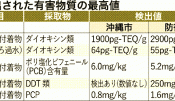
July 8, 2014 Ryukyu Shimpo
On July 7, the Okinawa Defense Bureau and city government released the results of their investigation into contamination from barrels found at a soccer ground on land returned by the U.S. military in Okinawa City. They detected dioxin and other harmful ingredients in all substances analyzed. The samples were taken from fouling material and bottom soil in the area around the barrels.
The city detected dioxin in the filtrate water around the barrels at a level 64 times the Environmental Quality Standard for groundwater. The bureau detected dioxin at 55 times the standard. The city detected dioxin in fouling material at a level 2.9 times the normal standard for soil, while the bureau detected 1.9 times the standard.
The bureau and city took the same substance samples from 61 barrels and separately conducted their analysis.
The bureau detected dioxin at a level over the standard in five of the fouling material samples, while the city detected three.
Although they detected dioxin at a level under the accepted standard in all 29 samples taken from bottom soil, the levels were higher than that requiring caution.
The bureau and city found the key ingredients of Agent Orange–2, 4, 5-T, trichlorophenoxyacetic acid and 2, 4-dichlorophenoxyacetic in the filtrate water around the barrels.
However, the bureau said, “We cannot use it as proof of the defoliant. We infer that it is chemical herbicides.” The city stated that harmful substances, including polychlorinated biphenyls and Pentachlorophenol caused the pollution of the soil and groundwater at the site. However, they declined to say that what they found was Agent Orange.
Regarding the results of their investigation, the bureau and city stated that there was no influence on the surrounding environment and groundwater at the site.
(English translation by T&CT)
Go to Japanese
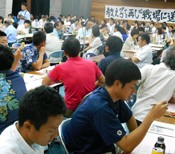
July 6, 2014 Ikue Nakaima of Ryukyu Shimpo
“Teacher, do we have to go to war?”
A regular meeting of the High School and Handicapped People’s School Teachers’ and Staff Union was held in Naha City on July 4. The teachers reported that their students were concerned about the Japanese Government’s decision to change the interpretation of the Constitution to enable the nation to exercise its right to collective self-defense. They have reacted sensitively to the change in Japan, which many believe poses a risk of leading to war.
At a high school in the northern area, students were forward about their concern and continuously pressed their teachers for answers when classes started. One of them said, “Is war going to occur?” another said, “It is dangerous if there is a military base built in Henoko, isn’t it?”
The teacher was surprised by such reactions from the students, and explained that as 74 percent of the U.S. military facilities in Japan are concentrated in Okinawa, there is a possibility that if the U.S. enters a war with another country, Okinawa will become the target of attacks from enemies.
“Then, what can we do now? Once the government has decided, can it be changed?” the student continued to ask. The teacher told the students, “When you become 20 years old, you will have a right to vote. Think about how you want the Japanese government to be, and go and vote.”
At a school in the central area, students suggested talking about the right to collective self-defense. One teacher said they could sense students were highly interested in this issue because they talked about it in many different classes.
At a school in the southern area, students told one of their teachers, “Teacher, it’s not the right time to give us a regular lecture.” Students, who had previously not shown any interest in the U.S. military base issues, suggested discussing it. The teacher said students have sensed the Japanese society is about to change.
A regular meeting on July 4 was held under the slogan of “Don’t send students to the battlefield again.” This slogan, made in 1951 by the union, refers to Okinawa’s history. One of the teachers said, “Until now, I have never pondered the meaning of this slogan as much as I am now. I do not want to send any of my students to the battlefield.”
(English translation by T&CT and Megumi Chibana)
Go to Japanese

July 5, 2014 Ryukyu Shimpo
On July 4, at the golden palace of the Shurijo Castle Park in Naha, a special exhibition titled “Beautiful…orisen-I, II of Ryukyu kingdom” began. It will be on until September 17. It is the first time that a special exhibition has been held at the golden palace, which was restored in January this year. The exhibition showcases a pattern and sample book edited by the royal government for weavers who were obligated to make cloth for tribute to the royal palace. It shows also the yellow-colored muruduchiri costume pattern that was used. During the exhibition, a total of 51 works will be displayed.
Experts believe that this costume was the one worn by a royal family member in the 19th century. This is said to be as historically valuable as those included in a list titled “National Treasure: Ryukyu King Sho Family Related Documents.”
Yasuyuki Uezu, a curator of the Shurijo Castle Park , said, “We want many people who are interested in dyed or woven fabric works during the Ryukyu Kingdom era to visit the exhibition. There are a few preserved costumes with the muruduchiri pattern, which are national-treasure-class.”
The exhibition “Protect! treasure of Ryukyu” started on July 4 and goes until September 11 at the south palace in Shurijo Castle Park.
(English translation by T&CT)
Go to Japanese
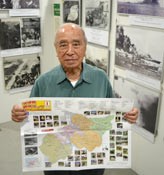
July 1, 2014 Ryukyu Shimpo
The Okinawa International Peace Research Institute renewed its Battle of Okinawa exhibition on June 19. It displays 755 photographs which Masahide Ota, the president of the Institute and former Okinawa Governor, collected from the U.S. National Archives and Records Administration at the exhibition hall in Naha City. These photographs are showcased with English and Japanese description in chronological order from the night before the Battle of Okinawa to the early reconstruction period when the United States built military bases in Okinawa .
The Institute has also created an A2 size battle site map of Naha, with a description and photograph. This map can be purchased for 500 yen. It plans to publish a series of guide maps for touring the battle sites in all 41 cities, towns and villages.
Former Governor Ota who was drafted into the Japanese Imperial Army as a member of Tekketsu Kinnoutai (the Blood and Iron Student corps) said, “We can learn an important lesson from the Battle of Okinawa by looking at those photographs. I want many local children to visit the exhibition in the institution, which is walking distance from the Naha Bus Terminal.”
Admission fee for adults is 500 yen, 300 yen for junior and high school students, and free for elementary school students and infants. The exhibition hall will open from 9:00 a.m. to 6:00 p.m. It is closed on Thursday. For more details, please call the Institute on 098 (979) 9490.
(English translation by T&CT, Hitomi Shinzato)
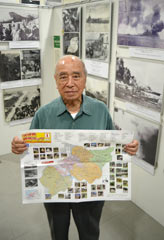
On June 19, Former Governor Masahide Ota showed a guide map for touring the battle sites at the exhibition hall of the Okinawa International Peace Research Institute in Naha.
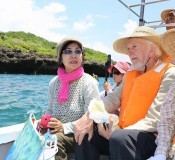
July 2, 2014 Ryukyu Shimpo
On July 2, Gavan McCormack, who is a researcher of modern Japanese history and an emeritus professor of the Australia National University, visited Henoko in Nago. From a boat, he observed the sea around Henoko and Oura Bay, where the U.S. and Japanese governments plan to build a new base to replace Marine Corps Air Station Futenma.
McCormack took about two hours to survey the marine area, which is a feeding site of dugongs and has Porites tenuis, a type of coral that has been there for 400 years. Masako Suzuki, who is the representative of the Association to Protect the Northernmost Dugong, and Etsuko Urashima, who is a joint representative of the Association of the 10 Districts North of Futami Who Do Not Want a Base, explained the current situation to him.
McCormack said he never imagined the sea was so beautiful. He stressed that people must protect dugongs and nature. On July 1, the Japanese Government decided to change the interpretation of the Constitution to enable the nation to exercise its right to collective self-defense at a cabinet meeting. At the same time, the government started constructing the new military base in Henoko. Regarding this new development, McCormack stated that he had never witnessed such a critical situation in Henoko despite visiting there for 20 years.
(English translation by T&CT and Lima Tokumori)
Go to Japanese









 Webcam(Kokusai Street)
Webcam(Kokusai Street)


